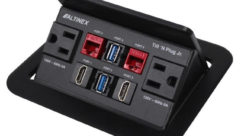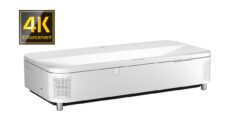
Four Tech Trends in Education
Jul 16, 2010 2:38 PM,
By Dan Daley
HD, IT, audio processing, and video capture make the grade in education installs.

Sidebar
High-tech Desks

The newly opened Academic Building at Ringling College of Art and Design in Sarasota, Fla., emphasizes digital HD video and a high-end surround audio system. AVI-SPL designed even the most basic classrooms with HD because students, already exposed to this format in their everyday lives, expect it in the classroom environment as well.
One of the more striking collateral aspects of the two-year-long economic recession has been how the spike in unemployment appears to be driving tens of thousands of new students to schools. Two-year colleges nationwide are scrambling to keep up with a 17 percent increase in enrollment this year, according to the American Association of Community Colleges, and students headed to school want to bring their personal media experience with them. The same phenomenon that brought about the home theater revolution and put high-definition video in houses of worship is causing enhanced AV to become part of the new education experience. That’s changing the nature of education and education AV, and creating an opportunity for integrators who can help conceive and deliver on digital trends such as IT, signal processing, and networking. In the process, pro AV integrators are also drawing on technology from broadcast, IT, and home theater markets to build the modern campus.

To distribute a digital HD signal throughout the Academic Building at Ringling College, AVI-SPL used 17 Gefen DVIKVM-441 DVI swiitchers with Extron 60-734-03 extenders running on Cat-5e cabling.
Trend 1: Bigger Picture and Sound
The same phenomenon that brought about the home theater revolution and put high-definition video in houses of worship has reached Ringling College of Art and Design, in Sarasota, Fla. The newly opened five-story Academic Building emphasizes digital HD video and a high-end surround audio system. The visual drama at the facility comes in part from a dozen Da-LiteContour Electrol 88397 retractable 133in. diagonal display screens hung from the exposed rafters of the classroom ceilings as well as a 193in. Da-Lite 16×9 screen used in the auditorium. These are illuminated by BenQ WXGA projectors suspended in the rear of the classrooms and a MitsubishiFL7000U projector with a long-throw lens.
“I’d never encountered this much emphasis on digital HD in an educational setting before—even the most basic classrooms had to be HD—but I can see how we’ll see more of it in the future,” says Jamie Knoop, AVI-SPL’s sales engineer on the project, which opened last fall. To distribute a digital HD signal throughout the 85,000-square-foot facility, the integrator used 17 GefenEXT-DVIKVM-441 DVI switchers in conjunction with Extron60-734-03 extenders running on Cat-5e cabling. In the auditorium, AVI-SPL used an Extron MGP 464 multiview processor.
Graphics and fine arts schools have been particularly proactive in advertising recently, and that competitiveness is being reflected as they seek to use installed technology to help differentiate themselves in a crowded marketplace. Knoop set up a shootout between projectors to find the one that offered the best color reproduction. Acknowledging the subjective nature of such a comparison, Knoop says they left the final decision to the school’s head of AV, Iva Lovell, who chose the BenQ WXGA projectors after comparing actual instructional program material sourced from a laptop.
Despite the extra-large video screens, the classrooms are fairly standard-sized, holding 18 to 20 students comfortably and ensuring all can see the display clearly from the rear row, about 20ft. away. In the largest classrooms, however, integrators used two screens to address the extra width. Electro-Voice SL10-2V loudspeakers serve as left-right stereo pair and surround loudspeakers throughout the classrooms. Creating a center channel for each of the two screens would have been tricky, due to the fact that the ceiling layout did not permit hanging a loudspeaker above the screens and the Da-Lites are not porous to allow use of a rear-mounted center-channel loudspeaker. The solution was to use an EAW UB42 loudspeaker mounted in between the two screens. The 170×50 degree dispersion pattern is able to cast center-channel information widely enough for the rooms. Surround audio processing is done via a 7.1 DTS system using Crestron’s C2N-DAP8 surround-sound processor and a Biamp 8150 amplifier, a setup found in high-end home theater designs.
“Students coming to school now have higher expectations about what the media systems they’ll be taught on will be like,” Knoop says. “They have HD and home theater systems at home. They expect that to be the norm, including at school. Especially for things like graphic arts, the ability to display color accurately is going to be very important going forward.”

There’s a heightened emphasis on audio at the Medical Partnership facility in Athens, Ga. In the classrooms, TSAV equipped the rooms with one audio system for speech and one for larger-bandwidth program materials. In the gross anatomy labs, the instructors use a Sennheiser ME36 mic that hangs over each anatomy table. Photo by Julie and David Fisher, J and D Images
Trend 2: Enhanced Audio
Another trend happening in education is a heightened emphasis on quality sound. The University of Georgia and Medical College of Georgia (UGA/MCG) created a new jointly operated medical college in Athens, Ga., scheduled to begin classes next month. The Medical Partnership facility is actually the converted historic Athens Cotton and Wool Mill, built in 1857. Systems designer TSAV and integrator Multi Media Services (MMS) were given a mandate to turn the landmarked space into an advanced medical teaching facility with special attention given to historic preservation.
To complement the larger 16:10-aspect-ratio screens and the Tandberg HD videoconferencing system, the classrooms have two separate audio systems—one for speech and the other for larger-bandwidth program materials. The latter consists of a pair of Bose Panaray 302 loudspeakers mounted in the front of the rooms on either side of a Da-Lite 11in. Cosmopolitan Electrol projection screen, and a second set of ceiling-mounted Lowell DSQ 810-72 loudspeakers for distributed audio from the instructor’s podium. The two distinct loudspeaker sets give the visual program material an audio cue. “With the speakers mounted in the front of the room, it draws students’ attention to the screens. It’s a directional cue,” says MMS project manager Joe Loughman. “It makes it very distinct from the information [coming] from the teacher’s podium.”
In a variety of ways, the facility has more audio processing than might be typical in an educational install. The Crown Audio CDi 1000 amplifiers have their own DSP, which augments the Biamp Nexia TC DSP processor also applied to the audio signal path. “You’d find this level of processing in some high-end corporate installations, but not usually in schools,” Loughman says. The processing includes equalization notched at around 75Hz to 80Hz to filter out ambient noise such as HVAC rumble and—peculiar to this environment—the sound of footsteps from the historic wooden mill floor above. Microphone choices also contribute to heightened voice intelligibility. TSAV chose Shure SLX series wireless handheld microphones for instructor and student hand-around use, and hung Shure MX202 condenser microphones from the ceiling. In the gross anatomy lab, the instructors use a Sennheiser ME36, a back-electret condenser microphone capsule based on Sennheiser’s KE10 capsule and used in Sennheiser’s MKE 40 lavalier and MKE44P stereo microphones, that hangs over each anatomy table.
1
Four Tech Trends in Education
Jul 16, 2010 2:38 PM,
By Dan Daley
HD, IT, audio processing, and video capture make the grade in education installs.

At the Medical Partnership facility, video capture was essential. TSAV installed an extensive video capture system that includes Panasonic WV-CS574 PTZ cameras.
Trend 3: Video Capture
At the new Medical Partnership medical college facility in Athen, Ga., TSAV installed an extensive video capture system that extended from patient encounter areas to a central control room and networked storage. TSAV mounted Panasonic WV-CS574 security-type cameras on PTZ platform. The image is encoded in standard-def MPEG4 and streamed via Extron MAV Plus 2412 composite matrix switchers and a series of Extron MDA 3V 1×3 composite distribution amplifiers, and VBrick MPEG4 CIF encoders.
Content is stored on a pair of Rorke Data Galaxy HDX2 drives with almost 7TB of storage and can be recalled and viewed anywhere on the network. “Between distance learning and teacher evaluation and other applications, schools want to capture more of what goes on in their own classrooms and turn it into content for future use,” says Keith Reardigan, sales engineer for TSAV on the UGA/MCG Medical Partnership project, who notes that the declining cost of videocameras and capture and storage technology are contributing to the trend (as probably are an increase legal liability and security concerns).
Capturing audio and video live in the classroom presents some challenges not often found in education installs, Reardigan says. “First, you have to determine the degree of resolution you’re going to need, based on the application,” he says. While most content will do fine at standard-definition levels, medical and fine-arts applications may call for higher resolutions. Similarly, music will also do better at a sampling rate of least 48kHz. “Then, based on the applications and degrees of resolution, you have to light the classrooms appropriately, and in the case of audio, do acoustical treatments in order to keep the sound intelligible,” he says. “Classroom design is going to have to adapt to using it as a space in which to capture content.”
Reardigan adds that 720p is rapidly becoming an ad hoc standard in upscale academic systems designs. “We’re seeing 720 as the baseline spec now, and that’s a very recent development. I don’t think you would have seen anything but standard definition even a couple of years ago,” he says. “Most of the [instructional] content that’s available does not exceed 720p and that’s fine for most everything but critical medical imaging.” But if and when the standard moves to 1080p, Reardigan would not be surprised if it were medical teaching applications that contribute considerably to it. The school also implemented a Tandberg videoconferencing system that can operate at 1080p resolution.

Recognizing that Savannah College of Art & Design’s video production arts facility would need a software solution that would work with the schools four-source, tapeless, file-based workflow, CTG contracted DNF Controls to write custom software to handle the schools complex file-naming process.
Trend 4: I/T Comes To the Fore
Atlanta-based integrator CTG has found that media arts schools are especially pressured to configure their systems at the cutting edge of the technology. “They understand that their graduates will be stepping into some very sophisticated work environments, and they have to be prepared for that by the school,” says CTG Vice President Steve McCormick.
That concept first came to the fore three years ago when the company did the systems installation at the Atlanta campus of SAE, an international audio media arts college. “What we did there was take advantage of a trend of ‘mixing in the box,” McCormick explains, referring to the Avid’s Pro Tools system’s ability to create stereo audio mixes without having to leave the computer/software environment. “They were putting the school on an all-file basis. All the content was created in the same studio it was recorded in; then it could be moved throughout the facility on data CDs and DVDs or on hard drives.” CTG also installed additional Cat-5e cabling in anticipation of a centralized server system to be installed at a later date.
The Savannah College of Art & Design’s new Atlanta campus is a former broadcast television facility that reopened as a video production arts school in late 2009. Here, CTG took the concept considerably further. The facility has a completely tapeless, file-based workflow that uses fiber cabling to route 1080p video from three Panasonic AK-HC3500 HD cameras to a 60TB Harris Nexio server, routed via a 32×32 Harris Panacea router. Additional digital audio, recorded via a Wheatstone D-7 console in its own suite in the studio, is embedded with the video. “The entire AV signal can go out over a single coaxial cable,” McCormick says.
Having audio and video embedded also serves the requirement that all production media be available as soon as possible for students to work on. In this case, it’s accessible to Apple Final Cut Pro-equipped student workstations within minutes of it hitting the server. But one of the costs of such rapid accessibility is the fact that, instead of picking up where it left off when action is cut—as it would in a linear workflow—in a file-based environment each new “on” creates an entirely new file. The challenge is to name that file quickly to allow it to be found for editing purposes. Multiply that times four sources, and it becomes a potential digital traffic jam. McCormick says his team recognized the need for a software solution for that issue in the RFP stage, and bringing that up to the client helped CTG secure the project. They contracted with
DNF Controls, which wrote custom software for an automated file-naming process that also ensures that SMPTE timecode is also applied to all files. “That turned out to be critical, both for us getting the job and for the school to be able to get the greatest benefit from their digital workflow,” McCormick says. The cost of the customized software is more than offset by the fact that the school can offer students near-instant access to production content. It also really underscores the importance of systems designers and integrators being aware not only of how education environments work but also of what is state of the art in the media sectors that schools are trying to teach.
Expect to see more advanced systems propositions in schools as competition for student dollars ramps up. The recession was painful for almost everyone, but one of the silver linings will be an academic environment far more attuned to high tech.
2










